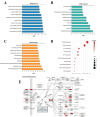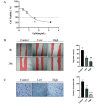Network Pharmacology Analysis and In Vitro Validation of the Active Ingredients and Potential Mechanisms of Gynostemma Pentaphyllum Against Esophageal Cancer
- PMID: 38243957
- PMCID: PMC12174898
- DOI: 10.2174/0113862073280183240108113853
Network Pharmacology Analysis and In Vitro Validation of the Active Ingredients and Potential Mechanisms of Gynostemma Pentaphyllum Against Esophageal Cancer
Abstract
Background: Esophageal cancer (EC) is one of the deadliest malignancies worldwide. Gynostemma pentaphyllum Thunb. Makino (GpM) has been used in traditional Chinese medicine as a treatment for tumors and hyperlipidemia. Nevertheless, the active components and underlying mechanisms of anti-EC effects of GpM remain elusive.
Objective: This study aims to determine the major active ingredients of GpM in the treatment of EC and to explore their molecular mechanisms by using network pharmacology, molecular docking, and in vitro experiments.
Methods: Firstly, active ingredients and potential targets of GpM, as well as targets of EC, were screened in relevant databases to construct a compound-target network and a protein-protein interaction (PPI) network that narrowed down the pool of ingredients and targets. This was followed by gene ontology (GO) functional and Kyoto Encyclopedia of Genes and Genomes (KEGG) pathway enrichment analyses. Next, molecular docking, ADME and toxicity risk prediction, cell viability assays, in vitro scratch assays, Transwell cell invasion assays, and Western blotting analysis were subsequently applied to validate the results of the network analysis.
Results: The screening produced a total of 21 active ingredients and 167 ingredient-related targets for GpM, along with 2653 targets for EC. The PPI network analysis highlighted three targets of interest, namely AKT1, TP53, and VEGFA, and the compound-target network identified three possible active ingredients: quercetin, rhamnazin, and isofucosterol. GO and EKGG indicated that the mechanism of action might be related to the PI3K/AKT signaling pathway as well as the regulation of cell motility and cell migration. Molecular docking and pharmacokinetic analyses suggest that quercetin and isoprostanoid sterols may have therapeutic value and safety for EC. The in vitro experiments confirmed that GpM can inhibit EC cell proliferation, migration, and invasion and suppress PI3K and AKT phosphorylation.
Conclusion: Our findings indicate that GpM exerts its anti-tumor effect on EC by inhibiting EC cell migration and invasion via downregulation of the PI3K/AKT signaling pathway. Hence, we have reason to believe that GpM could be a promising candidate for the treatment of EC.
Keywords: Gynostemma pentaphyllum; KYSE- 150.; PI3K/AKT; esophageal cancer; molecular docking; network pharmacology.
Copyright© Bentham Science Publishers; For any queries, please email at epub@benthamscience.net.
Conflict of interest statement
The authors declare no conflict of interest, financial or otherwise.
Figures






Similar articles
-
Integrated network pharmacology and experimental validation reveal EGFR/p53/Bcl-2-mediated anti-hepatocellular carcinoma effects of Zedoary Turmeric Oil.J Ethnopharmacol. 2025 Aug 29;352:120241. doi: 10.1016/j.jep.2025.120241. Epub 2025 Jul 3. J Ethnopharmacol. 2025. PMID: 40615101
-
Exploring the Molecular Targets and Therapeutic Potential of Coptisine in Colon Cancer: A Network Pharmacology Approach.Curr Med Chem. 2025;32(16):3295-3308. doi: 10.2174/0109298673262553231227075800. Curr Med Chem. 2025. PMID: 38231070
-
Multi-target Mechanisms of Si-Ni-San on Anxious Insomnia: An Example of Network-pharmacology and Molecular Docking Analysis.Curr Med Chem. 2025;32(13):2640-2663. doi: 10.2174/0109298673299665240924090617. Curr Med Chem. 2025. PMID: 39410900 Free PMC article.
-
Study on the mechanism of Shujin Tongluo granules in treating cervical spondylosis based on network pharmacology and molecular docking.Medicine (Baltimore). 2023 Jul 21;102(29):e34030. doi: 10.1097/MD.0000000000034030. Medicine (Baltimore). 2023. PMID: 37478234 Free PMC article.
-
Exploring the mechanism of ShenGui capsule in treating heart failure based on network pharmacology and molecular docking: A review.Medicine (Baltimore). 2024 Apr 5;103(14):e37512. doi: 10.1097/MD.0000000000037512. Medicine (Baltimore). 2024. PMID: 38579077 Free PMC article. Review.
References
MeSH terms
Substances
Grants and funding
LinkOut - more resources
Full Text Sources
Medical
Research Materials
Miscellaneous

